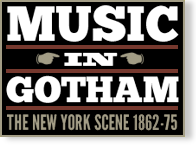Bells Concert July 4 Celebration
Event Information
Venue(s):
Trinity Church
Record Information
Status:
Published
Last Updated:
18 February 2024
Performance Date(s) and Time(s)
04 Jul 1872, 7:30 AM04 Jul 1872, 12:00 PM
Performers and/or Works Performed
Citations
“At 7:30 A. M., the bells of Trinity Church began to chime. Few persons, however, went down town at that early hour to listen to them. The first air chimed was ‘Red, White, and Blue,’ and was followed by Yankee Doodle, an air from Oberon, and several Scottish airs. The chimes again rang at noon, when the churchyard was thrown open. It was speedily filled with passers-by, who, while listening to the music, also scanned the curious inscriptions upon the weather-worn tombstones. The programme was somewhat more varied than in the morning.”
“The chimes of Trinity have rung out laden with music and patriotism as each succeeding Fourth of July since 1846 has been added to the perished festivals of dead years. Yesterday morning, while the lower city was deserted as on the Sabbath, and, but for the ever-recurring concussions of Chinese firecrackers and young America torpedoes, would have rivalled in quietude a ruined city, the bells began to play. Adam Mayer, as usual, rang the changes on eight bells; then Mr. Ayliffe rang on with the programme. ‘Red, White and Blue’ and ‘Yankee Doodle’ were followed by a melody from ‘Oberon.’ In time there came snatches of melodies from ‘Guy Mannering’ and ‘Strike the Silver Bells,’ in the ravishing sound of which one thought of Jean Ingelow, and the
Fairy wedding bells faintly runs to us,
Down in their fortunate parallels.
“The charming pictures of a vagabond fancy were only called into being to be hastily dispelled by the jangling rhythm of the ‘Bould Soger Boy,’ which rudely, but effectually, brought the listener once more back to the realities of the glorious Fourth, the fizzling of firecrackers and the dull, stupid reports of the noisy torpedoes. ‘Hail Columbia’ broke out then resonant and royal in its strength, and was succeeded by the pretty romantic airs from the ‘Child of the Regiment.’’’
[Brief paragraph listing the remaining programme—see above ].
“When the morning chimes had ended it was nearly nine o’clock, and from that time till nearly twelve Trinity and its churchyard were deserted. Then the people began to collect—not the large concourses of other years, but some four hundred men and women. Two hundred, perhaps, sat in the aisles and pews of the church, while the others wandered among the graves, pausing in little knots to decipher here and there some nearly effaced inscription. Many an old couple found their way to the flat and shattered slab of red sandstone that rests above the remains of Charlotte Temple, and their pensive looks showed how strong the impression remained upon their minds, produced when as children they read the sad story of her life and sorrows.
“Others mounted to the first lookout of the spire [paragraph continues with description of the listeners].
“At noon the same programme was rung, and at three o’clock the changes, and call for service was chimed as usual.”

